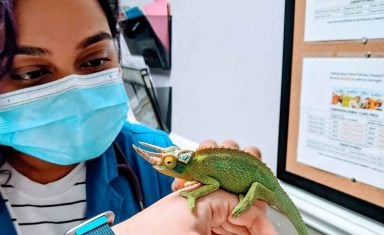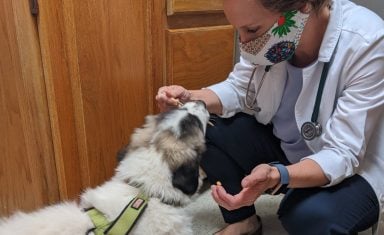Reptiles and other exotic pets have grown significantly in popularity over the past couple of decades. Due to advances in captive breeding, pet reptiles can be easily found in many different shapes, sizes, and colors and most don’t tend to take up a lot of space! Reptiles make great first pets due to their relative ease of care when compared to a dog or cat. Common beginner reptiles include leopard geckos, crested geckos, corn snakes, and bearded dragons. They tend to be very docile in nature and come in many different colors and patterns — also known in the industry as “morphs.”
Proper Husbandry for Reptiles
One major aspect of having a reptile as a pet is proper husbandry or habitat/housing. Each species has a different space, temperature, humidity, lighting, and dietary requirement, so it is imperative that thorough research is done on what is needed by the animal you want to keep as a pet beforehand. For example, some species of tortoise and certain lizards need a basking spot of up to 110F to keep themselves warm! Some species of snakes and geckos need a high humidity up to 60-70% to survive. So, make sure you have your equipment set up and functional to provide your animal with a suitable living environment before you bring your new pet home!
Finding the Best Reptile Vet
Another major aspect of keeping any pet, including reptiles, is routine veterinary care. When it comes to exotic animals, especially reptiles, this can be hard to find! One way to find a reptile vet in your area is to look on ARAV.org. This is the Association of Reptile and Amphibian Veterinarians and they not only provide good information on reptile health but can also help you find a trusted reptile vet! Due to shorter lifespans of most reptile species, routine veterinary care is vital in early detection and treatment of infectious and chronic diseases. Therefore, such visits can help prevent problems before they occur and allow your pet to live a long and healthy life.
Companion Animal Clinic in Blacksburg, VA cares for reptiles as does our sister hospital, Cedarcrest Animal Clinic in Fishersville, VA.
What to Expect at a Reptile Vet Visit
A vital part of a reptile vet visit is history and husbandry. As we “domesticate” reptiles and other exotic species, we have to work hard to ensure that we re-create their natural environment in which they can thrive. However, imitating these habitats is not always an easy task. Therefore, the first exam after you have acquired your scaley friend is essential in not only establishing a client-patient-doctor relationship, but also ensuring that your husbandry is appropriate for the animal.
Physical exam
Every veterinary visit includes a physical exam. These exams consist of thorough evaluation of your pet from head to tail. We will check your animal’s weight, evaluate general appearance and demeanor. Then we go on to checking individual organs such as eyes, ears, mouth, taking a heart rate, palpating the abdomen, and an orthopedic exam to evaluate for bone and joint disease. A physical exam is our initial diagnostic for any animal, whether it has fur, feathers, or scales.
Testing
Depending on the findings of the physical exam, further testing may be recommended to either diagnose a disease or illness or for routine screening. Bloodwork allows us to determine if there are any signs of infection/inflammation, anemia, and liver, kidney, or even calcium abnormalities. Another common test is a fecal parasite analysis that helps detect internal/GI parasites. It is very common for wild-caught, and even captive-bred, reptiles to carry the burden of parasites and they need to be treated appropriately for their overall health and even to prevent human transmission (zoonosis).
Imaging
Another essential diagnostic is imaging, including but not limited to, radiographs (x-rays) and ultrasound. Like in humans, radiographs allow us to “see” internally and evaluate the size, shape, and position of organs such as the heart, lungs, GI tract, and even reproductive systems! It also allows us to screen for any abnormalities such as foreign bodies, tumors, and fluid accumulations. Radiographs can be extremely helpful in assessing the status of a reptile’s bones and joints to screen for common chronic conditions such as metabolic bone disease and gout. Reptiles show clinical signs of these diseases when their husbandry isn’t appropriate such as lack of UV light or inappropriate diet.
When you first take your scaley friend to the vet, please ensure that you are aware of the animal’s husbandry along with transporting it in a safe container with an appropriate heat source if needed.
I hope this article has helped you become interested in the world of reptile keeping and aware of the challenges that come with it. Owning a pet is a great responsibility, and veterinary care is a pivotal part of it.
– Dr. Sonali Kadam
Companion Animal Clinic has been serving Blacksburg, Virginia and surrounding Montgomery and Christiansburg communities since 1974. We are an AAHA accredited veterinary hospital and provide quality, professional care for dogs, cats, exotics, and small mammals. Learn more about our amazing team.





